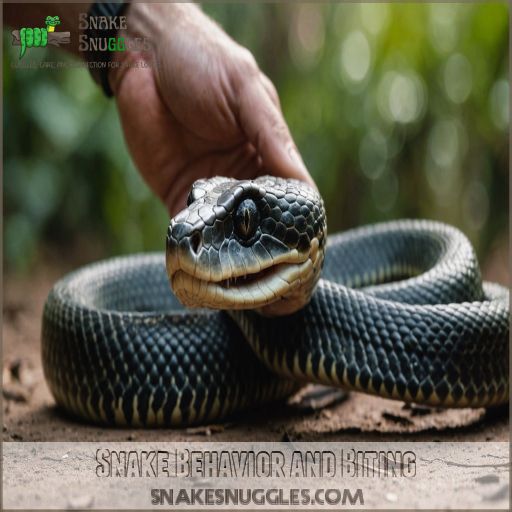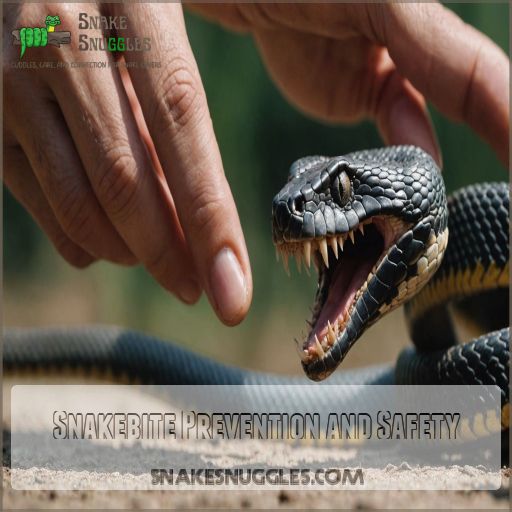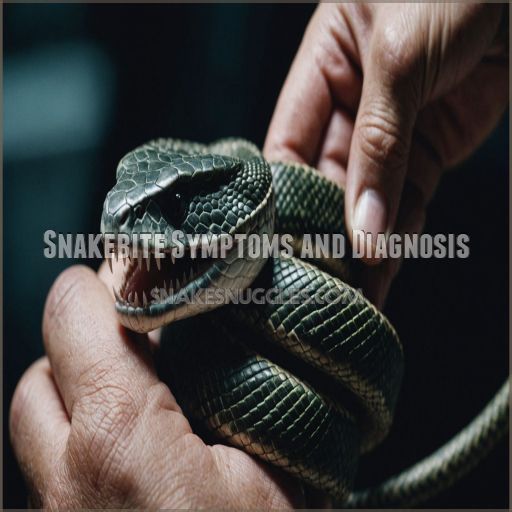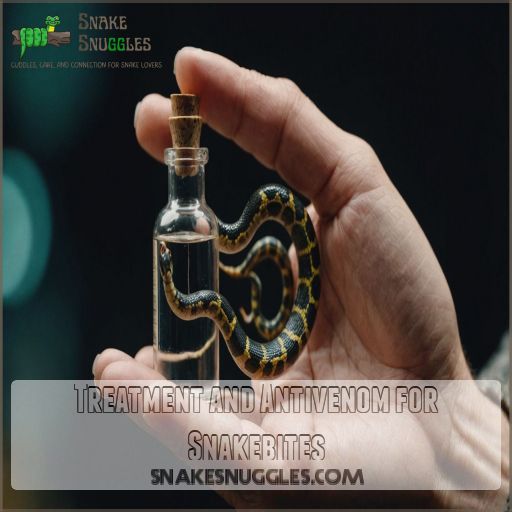This site is supported by our readers. We may earn a commission, at no cost to you, if you purchase through links.
 Curious about why snakes bite humans? It’s not because they woke up on the wrong side of the log! Snakes bite primarily out of fear and self-defense. Imagine this – if a snake detects sudden movements or feels cornered, it might mistake you for a predator or even prey. That’s when it might strike to protect itself.
Curious about why snakes bite humans? It’s not because they woke up on the wrong side of the log! Snakes bite primarily out of fear and self-defense. Imagine this – if a snake detects sudden movements or feels cornered, it might mistake you for a predator or even prey. That’s when it might strike to protect itself.
They’re also quite the homebodies and can get territorial. So, if you mistakenly wander into their neck of the woods, expect a less-than-warm welcome. Mishandling them is another surefire way to get bitten. Wondering how to stay safe and sound around these sneaky serpents? Read on!
Table Of Contents
- Key Takeaways
- Snake Behavior and Biting
- Types of Venomous Snakes
- Why Snakes Attack Humans
- Snake Venom and Its Effects
- Snakebite Prevention and Safety
- Snakebite Symptoms and Diagnosis
- Treatment and Antivenom for Snakebites
- Frequently Asked Questions (FAQs)
- Why do snakes try to bite you?
- Why do some snakes attack humans?
- What is the cause of snake bite?
- How do you stop snakes from biting you?
- Can snakes bite multiple times during an attack?
- What are the long-term effects of a snakebite?
- How can I identify a venomous snake bite?
- What should I do if I witness someone getting bitten?
- Are there any natural remedies for snakebite treatment?
- Conclusion
Key Takeaways
- Snakes bite mainly out of fear and self-defense; they’re like the neighborhood watch with scales, keeping an eye on sudden movements that might signal danger.
- Wandering into a snake’s territory can feel like crashing a private party—you’re likely to get a less-than-warm welcome, so tread lightly and respect their space.
- Mistaken identity isn’t just a Hollywood plot—snakes can confuse you with prey if you make sudden moves, leading to an unintended bite.
- Handling snakes is a bit like playing with fire; they aren’t fans of surprise hugs, so give them some breathing room and avoid poking the serpent.
Snake Behavior and Biting
Snakes are fascinating creatures, but their biting behavior can be quite alarming. Understanding why snakes attack humans is the first step in staying safe around these slithery reptiles, especially if you’re dealing with a sudden change in behavior.
Defensive Mechanisms in Snakes
When snakes feel threatened, they’ve got some sneaky ways to defend themselves.
It’s not just about striking with fangs and venom.
Camouflage: blend into surroundings, a method that allows them to hide from predators, is an effective defense tactic.
Hissing: a warning sign, is another way snakes deter potential threats, signaling to the predator that it’s better to back off.
Quick strike: a fast defensive reaction, is a desperate yet effective measure snakes use when caught off guard.
Territorial Behavior and Biting
You might think snakes are secretive, but they can be downright territorial!
Their aggression isn’t just for show—it’s a defensive dance for mating, habitat, and food.
Understanding their boundaries helps you stay safe and reduces snakebite risks.
Hunting and Feeding Habits
Stepping away from territorial instincts, let’s explore snakes’ hunting and feeding habits.
These sly serpents employ:
- Ambush tactics for unsuspecting prey
- Precision in venom delivery
- Diverse venom evolution for efficiency
- Unique digestive processes
Social Interactions and Biting
Snakes may bite during social interactions, like mating rituals or territorial disputes.
Understanding their warning signs, like hissing or coiled posture, can help avoid confrontation.
Respect their space, and they’re less likely to strike.
| Snake Social Behaviors | Potential Triggers |
|---|---|
| Mating | Territorial Disputes |
| Dominance Displays | Perceived Threats |
Types of Venomous Snakes
You might think snakes only bite in movies, but understanding their types, like front-fanged vipers and rear-fanged colubrids, helps explain their behavior.
These scaly critters have surprising tactics for keeping us on our toes, and knowing a stiletto snake from a boomslang might save you some literal legwork!
Front-Fanged Snakes (Viperidae and Elapidae)
When pondering why snakes bite humans, front-fanged vipers and elapids frequently star in the story.
With evolved venom and distinct fangs, these Viperidae and Elapidae families play pivotal roles in medicine and snakebite treatment, reminding us that nature’s toolkit is complex!
Rear-Fanged Snakes (Colubridae)
A fascinating group, rear-fanged snakes in Colubridae have evolved diverse venom for survival.
Their bites usually cause mild complications, but it’s wise to stay cautious.
Remember for snakebites: 1. Calmly assess the situation, 2. Seek immediate medical help, 3. Avoid panicking!
Atractaspididae (Stiletto Snakes)
Atractaspididae, or stiletto snakes, are a lesser-known group of venomous snakes.
These stealthy predators possess potent venom and a unique striking mechanism.
They are a formidable yet often overlooked part of the snake kingdom.
Other Venomous Snake Families
Now that you’re aware of stiletto snakes, let’s explore other venomous snake families.
From reclusive Colubridae with their rear-fanged adaptations to the feared inland taipan and the swift black mamba, understanding these creatures helps you stay safe in their diverse habitats.
Why Snakes Attack Humans
You’re enjoying a hike when suddenly a snake lashes out, and you wonder why.
Snakes bite humans mostly out of fear and self-defense, mistaking us for a threat or even sometimes confusing us with prey, making them like your overly territorial neighbor who thinks your mailbox is his.
Fear and Self-Defense
Understanding snake behavior reveals their defensive instincts. Snakes often bite out of fear responses.
- They strike when threatened.
- They feel cornered.
- They aim to deter predators.
- They react to sudden movements.
Survival strategies, like these, are essential for snakes.
Territorial Protection
Snakes fiercely guard their territory, ready to strike if they feel threatened. Respect their space – keep your distance and avoid sudden movements near their habitat. A snake’s warning signs, like coiling or hissing, signal it’s time to back off.
Respect their space – keep your distance and avoid sudden movements near their habitat.
A snake’s warning signs, like coiling or hissing, signal it’s time to back off.
Snakes fiercely guard their territory, ready to strike if they feel threatened.
| Snake Markings | Defense Signals | Habitat Boundaries | Predator Interactions |
|---|---|---|---|
| Vibrant colors | Coiling | Dens and burrows | Protecting young |
| Distinct patterns | Hissing | Basking spots | Competing for resources |
| Rattle tails | Striking | Hiding places | Territorial disputes |
| Hooded necks | Lunging | Foraging areas | Defending territory |
Mistaking Humans for Prey
Though snakes often prioritize territorial safety, sometimes their vision plays tricks on them. Your sudden movement might resemble a smaller prey, leading to a mistaken bite.
Consider these triggers:
- Snake size
- Prey size
- Human movement
- Coloration
- Camouflage
Provocation and Handling
If you’re thinking about handling snakes, remember: snakes don’t appreciate surprise hugs. Mishandling or provoking them can lead to bites.
Here’s a table highlighting myths to bust and tips for safety:
| Myth | Reality | Action |
|---|---|---|
| Snakes like being held. | They often feel stressed. | Handle with care. |
| All snakes are deadly. | Not every snake is venomous. | Learn to identify. |
| Venomous snakes bite everyone. | They only bite when threatened. | Stay calm. |
Snake Venom and Its Effects
When a snake bites, it’s not just a hasty decision; their venom comes in a variety of types designed for specific effects, whether it’s Viperidae’s preference for ruining your blood’s day or Elapidae’s knack for silencing your nerves.
Each type has a targeted mission, whether it’s causing intense pain, paralysis, or turning tissue into goo, and understanding this can help you appreciate why you’d want to keep a safe distance.
While we may think snakes have an over-the-top flair for drama, their venom is all business.
Haemotoxic Venom (Viperidae)
Viper venom is haemotoxic, attacking the circulatory system and causing bleeding or clotting issues.
Boomslang venom contains enzymes that disrupt blood-clotting, leading to uncontrollable internal bleeding – a potentially fatal hemorrhagic syndrome requiring prompt antivenom therapy.
Neurotoxic Venom (Elapidae)
Let’s explore neurotoxic venom’s peculiarities, especially from elapids like cobras.
Neurotoxin effects can cause:
- Paralysis—akin to your phone freezing at 1%.
- Breathing issues—it’s no laughing matter.
- Antivenom development—thank goodness for scientific saviors against elapid diversity.
Cytotoxic Venom (Rattlesnakes)
Rattlesnake venom can be a real doozy, causing tissue damage and necrosis.
You know, it’s like leaving a banana out too long—things get mushy fast!
Quick antivenom treatment is absolutely essential to stop further harm and save the day.
Other Venom Types (Myotoxins, Cardiotoxins, Sarafotoxins)
Snake venom is like a mixed bag of surprises. Some contain myotoxins, attacking muscles; others with cardiotoxins target the heart. Then there are sarafotoxins affecting blood vessels. Fascinating, right? Here’s the deal:
- Myotoxins – Muscle damage
- Cardiotoxins – Heart attacks
- Sarafotoxins – Vascular havoc
- Venomous snake diversity – Nature’s brilliance, a testament to snake venom composition
Snakebite Prevention and Safety
Snakes may bite when they feel threatened or are protecting their territory.
To stay safe, it’s really important to avoid snake habitats, wear protective gear, and handle snakes with extreme caution – or better yet, leave them be.
Avoiding Snake Habitats and Areas
Knowing snake venom’s effects makes it really important to steer clear of snake habitats like forests and grasslands.
Hiking safety means staying on paths, avoiding tall grass like it’s lava.
Camping precautions? Check water sources and backyard risks. Snakes love cozy corners, so stay sharp!
Wearing Protective Clothing and Gear
Don’t let a sneaky snake ruin your day! Equip yourself with sturdy boots, gloves, and pants to prevent bites. Consider headwear for extra protection. Opt for bright clothing to boost visibility. Stay safe, and confidently navigate areas where snakes dwell.
Being Aware of Surroundings and Snakes
Protective gear does wonders, but you’ll want to be aware of your surroundings too. Keep an eye out for:
- Snake identification tips—know your local reptiles like the Eastern Diamondback.
- Habitat awareness—where do snakes hang out?
- Seasonal risks—certain times are snake hotspots.
- Hiking safety—stay on paths.
Safe Handling and Removal of Snakes
Safely handling snakes requires the right tools – snake hooks, tongs, and bags.
Identify the species first, then gently contain and relocate it.
Avoid direct contact – your safety comes first.
Check out this handy table for more tips:
| Tool | Use |
|---|---|
| Snake Hook | Gently guide and lift snakes |
| Snake Tongs | Secure and control venomous snakes to prevent snakebites |
| Snake Bag | Contain and transport snakes safely |
| Snake Trap | Capture snakes without direct contact |
Snakebite Symptoms and Diagnosis
You might think getting bitten by a snake is the start of a bad day, and you’d be right—especially when it comes to identifying venomous bites and understanding their symptoms.
We’ll guide you through the telltale signs and why it’s vital to seek medical help faster than a snake can slither.
Common Symptoms of Venomous Snakebites
When you’ve avoided snake habitats, yet find yourself bitten, recognizing symptoms is key.
Feel pain, swelling, or bleeding?
Experience nausea or dizziness?
These signs are your body’s rather dramatic way of saying, "Time to head to the hospital, pronto!
Identifying Venomous Snakebites
Quick as a flash, you find yourself questioning that snake-bite pattern. How do you spot venomous bite signs? Keep these tips handy:
- Two puncture wounds? Watch out!
- Severe swelling and pain.
- Sudden dizziness or trouble breathing.
Medical Diagnosis and Testing
Doctors will run blood tests, imaging scans, and venom detection to diagnose a snakebite.
Your clinical history and symptoms help them determine the right treatment.
Don’t wait – get medical care right away!
Importance of Prompt Medical Attention
You could say that timely intervention is the elephant in the room regarding snakebite complications!
- Rapid treatment minimizes complications.
- Delays increase mortality rates.
- Act quickly for antivenom availability.
Don’t fiddle while Rome burns—seek help fast!
Treatment and Antivenom for Snakebites
You’ve been bitten by a snake—don’t panic, because understanding how antivenom works can save your life!
From how it’s produced to the types and doses needed for effective treatment, we’ll guide you through this slithery science with insights that might just leave you hissing for more.
Antivenom Production and Challenges
Let’s talk about antivenom—the superhero serum against snakebites! Antivenom efficacy depends on quality production, but challenges like high cost, accessibility issues, and weak regulation trip it up.
Future research is vital to guarantee efficient, widely-available solutions.
Types of Antivenom (Monovalent and Polyvalent)
When snakebite strikes, two types of antivenom can help – monovalent for a single species or polyvalent for multiple. Each has its advantages, so work with your doctor to find the right fit.
- Monovalent antivenom targets a specific snake’s venom
- Polyvalent antivenom covers a broader range of venomous snakes
- Monovalent may be more effective but limited in scope
- Polyvalent provides wider protection but potentially less potent
Administration and Dosage of Antivenom
Ever wonder how antivenom delivery methods work? They’re super important for saving lives.
Dosage adjustments depend on the snake species and symptoms.
It’s not exactly immunization, but rather a rescue mission.
Medical Treatment and Care for Snakebites
So you’ve got your antivenom sorted; now what? Focus on snakebite care:
- Hospital Care: It’s priority numero uno.
- First Aid: Keep things steady, like your favorite playlist.
- Watch for Complications: Stay alert.
- Treatment Costs: Yep, they’re real, but your health’s priceless.
Frequently Asked Questions (FAQs)
Why do snakes try to bite you?
Snakes bite as a defensive measure when they feel threatened or startled.
Imagine them thinking, "Hey, buddy, back off!"
They want to keep control of their space and avoid danger.
You’d react too, right?
Why do some snakes attack humans?
Picture a snake as a shy celebrity—it wants to be left alone.
When you cross its path, it might "autograph" you with a bite, usually out of defense, fear, or because it feels threatened.
What is the cause of snake bite?
Snake bites often happen when snakes feel threatened, startled, or cornered.
They might think you’re attacking if you get too close.
It’s like stepping into a defensive creature’s personal space—bitety results can ensue!
How do you stop snakes from biting you?
Imagine a snake lunging at you, fangs bared – not a pretty sight!
But don’t worry, with a few savvy moves, you can keep those slithery critters at bay.
Stay alert, give ’em space, and you’ll be snake-bite free in no time!
Can snakes bite multiple times during an attack?
When a snake’s feeling threatened, it might try to bite multiple times during an attack.
It’s a wild dance of survival meant to protect itself or overpower prey (Source).
Like a boxer throwing punches in quick succession.
What are the long-term effects of a snakebite?
A snakebite’s long-term effects can linger like an unwelcome shadow, causing issues such as chronic pain, muscle weakness, or even permanent disability.
You need to get proper treatment and regain control over your health.
How can I identify a venomous snake bite?
You can spot a venomous snake bite through fang marks, swelling, and intense pain at the site of a Cottonmouth bite.
Watch for numbness, nausea, difficulty breathing, or shock.
When in doubt, get medical help faster than a speeding bullet!
What should I do if I witness someone getting bitten?
Imagine a friend suddenly yelps, clutching their arm – they’ve been bitten! Don’t panic; stay calm, call emergency services, and keep the person still.
Quickly identify the snake if possible, but don’t risk another bite.
Help is on the way!
Are there any natural remedies for snakebite treatment?
While some folks swear by garlic or turmeric teasing snake venom away, there’s no solid evidence backing any home remedies.
Best bet? High-tail it to a medical professional who can provide proper treatment and antivenom.
Conclusion
Did you know that over 5 million people worldwide suffer snakebites annually? It’s a staggering reminder of the importance of understanding why snakes bite humans.
By recognizing snakes’ defensive and territorial behaviors, you can minimize accidental encounters. Stay alert in snake-prone areas, wear protective clothing, and don’t provoke or mishandle these intriguing creatures.
Taking such precautions helps protect your safety, so you can enjoy nature without the fear of an unexpected slithery surprise!













